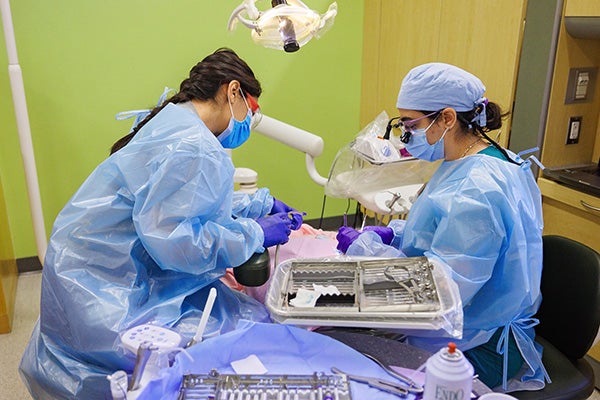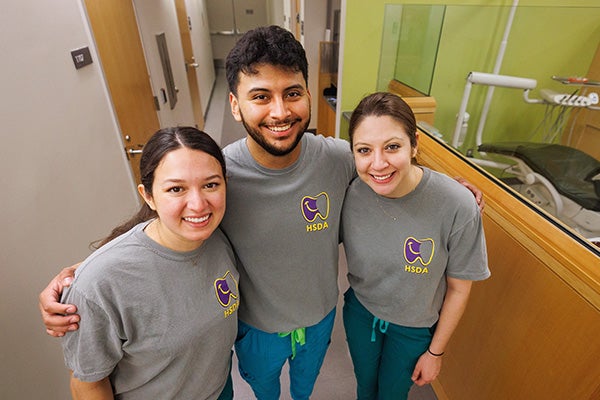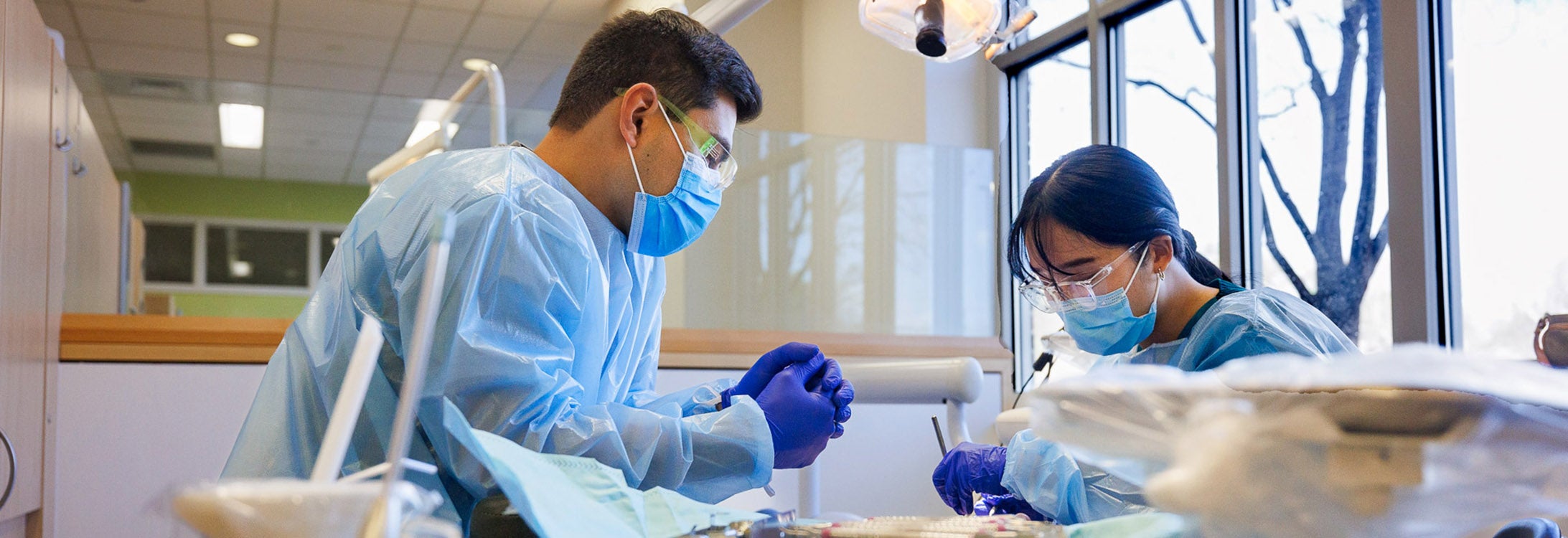SONRÍE CREATES SMILES
ECU dental school’s annual clinic provides oral health care for migrant farmworkers
Ross Hall, home of the East Carolina University School of Dental Medicine, stands on the edge of the Health Sciences Campus as a tangible reminder of the school’s promise to serve the people of the community, region and state.
On March 25 the building buzzed with more than 100 faculty, staff, students and residents who volunteered for the school’s third annual Sonríe Clinic that provides oral health care for migrant farmworkers. Sponsored by the school’s chapter of the Hispanic Student Dental Association (HSDA), the event is a link between health care resources and members of one of eastern North Carolina’s most vulnerable populations.

ECU School of Dental Medicine students Annette Echevarria, left, and Dalia Nashed provide care during the third annual Sonríe Clinic.
Twenty-four patients received treatment through almost 185 procedures including fillings, cleanings, extractions, a root canal and other services, totaling nearly $8,600 in care.
The event was co-sponsored by the North Carolina Dental Society Foundation, the Association of Mexicans in North Carolina, Inc. (AMEXCAN) and other community partners.
“This clinic was a success thanks to the excellent organization from HSDA and the support from volunteers, students and faculty,” said Acela Martinez Luna, the dental school’s division director of clinical implantology, clinical associate professor and one of the event’s faculty organizers. “Everybody had a role and worked together as a team to provide the best treatment possible.”
Patients were talked through the procedures, with students and faculty explaining each step in the process.
“The patients were appreciative of the care and information they received,” Martinez Luna said, “and having a translator all the time or providers speaking Spanish was special for them.”
Reaching those in need
Alex Betancourt, dental student and member of the HSDA executive board, said the event was an opportunity to reach those in need of dental care — and to help them build bridges toward resources in the community, including primary health care.
“The population the Sonríe Clinic aims to serve is a very vulnerable one,” he said. “Many of the patients have not seen a dentist in decades, while others have never seen one. Their lack of access to health care does not stop at oral care.”
Betancourt met a patient who had not had his oral health care needs met because of high blood pressure, which he had not known he had. The patient was referred to a primary care physician for cardiovascular evaluation.
“This encounter was a reminder of the many barriers this population faces to accessing care,” Betancourt said, “and a reminder of the amount of work needed to break down those barriers.”
The Sonríe Clinic made strides in addressing those obstacles.
“Serving the underserved is part of ECU SoDM’s mission,” said second-year dental student Oscar Jaimes. “The Sonríe Clinic is a great way to fulfill that mission by providing oral care to farm workers. A lot of these farm workers are Spanish-speaking and know minimal English. As a Hispanic dental student, I can be both their translator and provider.”
Jaimes said the clinic is also an opportunity for education.
“With these experiences, we can learn how to teach about oral health,” he said. “This oral knowledge is passed down from generation to generation, so we are not only improving the oral health of current patients, but also that of future generations. A lot of these patients have extensive dental needs. By volunteering in the Sonríe Clinic, we can learn how to manage these complicated cases and bring those skills wherever we end up.”
Student leaders
Third-year dental student Dalia Nashed has participated in all three of the school’s Sonríe Clinics over the years. The first two years, she assisted upperclassmen who were providing care.
“This year was really special that I was able to participate as a provider,” she said. “I decided to volunteer because I wanted to collaborate with other members of the school to serve the community and underserved populations. This experience taught me that it is possible to serve and to have a positive impact, even a small one, on the community.”

Hispanic Student Dental Association executive board members Ana Garcia, Alex Betancourt and Stephanie Camacho volunteered during the third annual Sonríe Clinic last month.
Third-year dental student and HSDA volunteer coordinator Stephanie Camacho headed up the student leadership efforts during the event, ensuring that student volunteers assisted where they were needed most.
“It was very rewarding being able to host an event that has such a great impact on the Hispanic community,” she said. “I myself come from the same population, so it means the world to me, being able to provide to a community I feel so strongly connected to. You could tell the patients were so grateful that we could help them in any way. Seeing so many smiles and the ‘thank you’s’ was amazing.”
Camacho said the experience leaves an impression that she will carry as a future dentist.
“I hope to continue to provide the same level of care in my practice,” she said. “I hope to be able to host similar events where I can help not only the Hispanic community but as many underserved populations as possible.”
Betancourt echoed that one of the School of Dental Medicine’s strongest new traditions is a springboard for making a difference across communities, the state and beyond.
“We understand the barriers this population faces,” he said. “We also have the ability to break those barriers by making them visible to those who might not know they exist. This situation is not unique to the population HSDA serves, or to oral health. There are many vulnerable populations that need people who are willing to break barriers. That is why diversity is so important, not just in dentistry — but in health care as a whole.”
